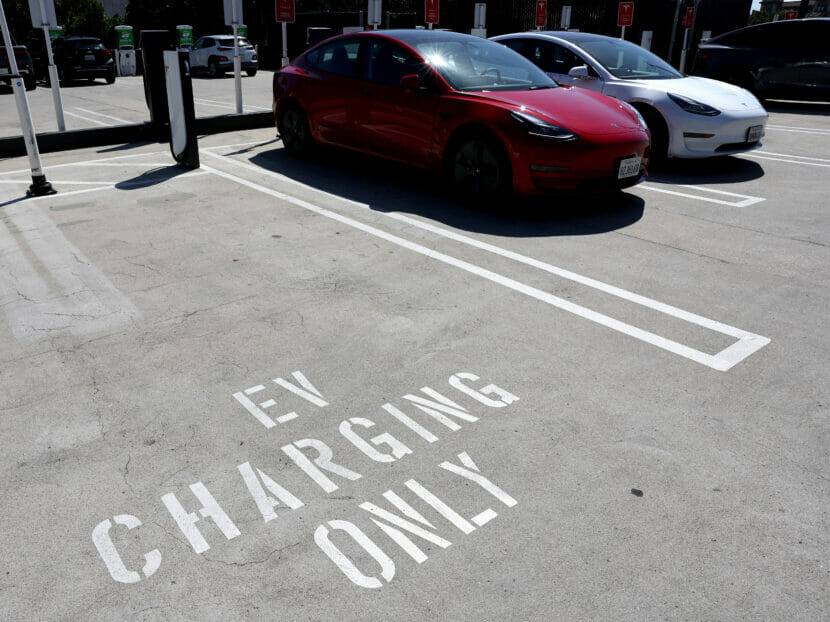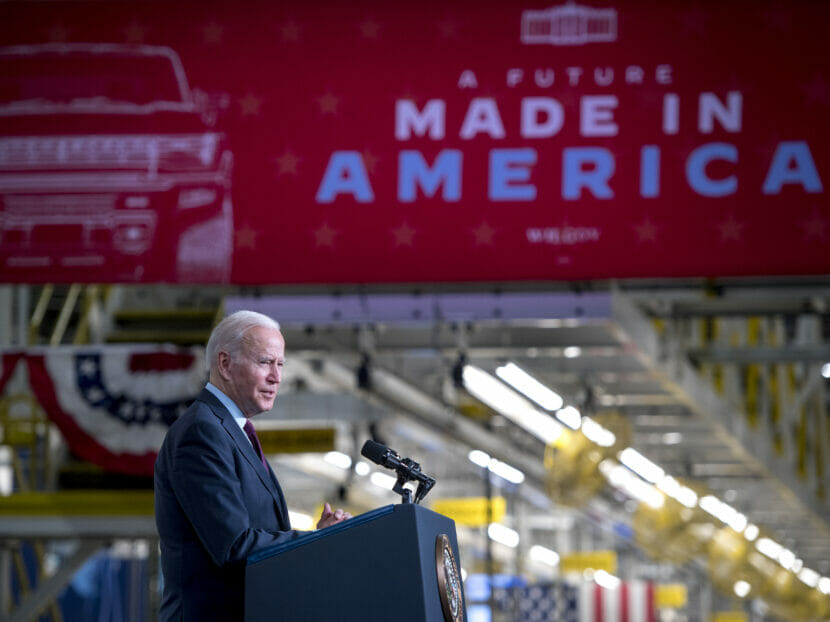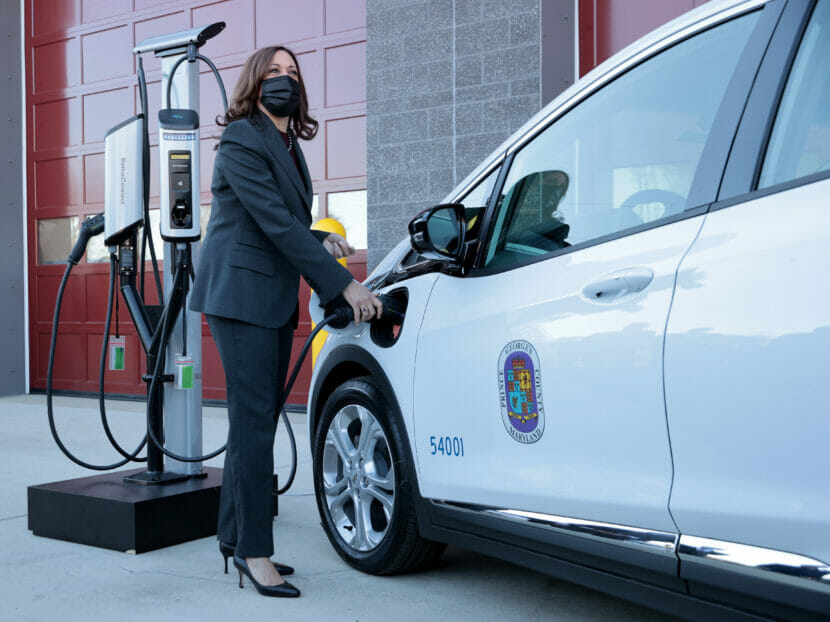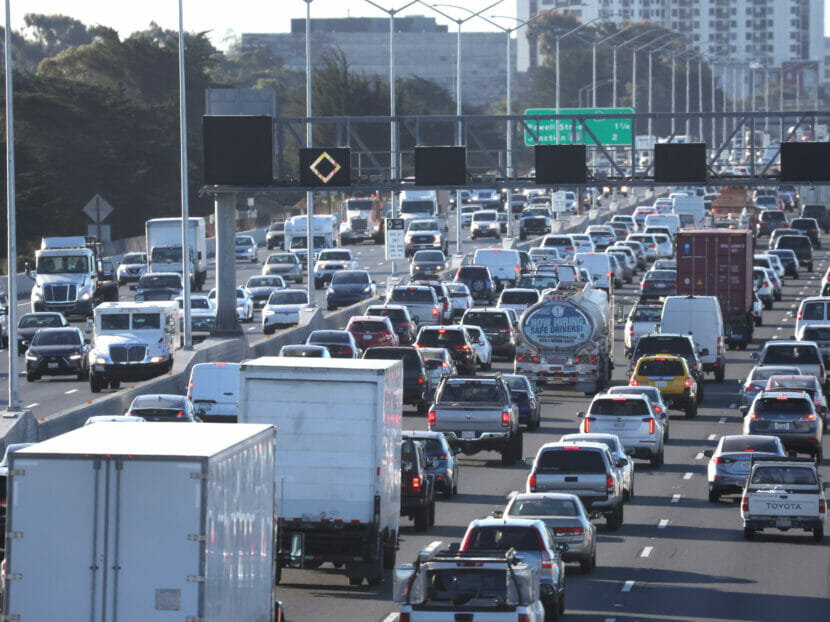The Environmental Protection Agency is proposing its most ambitious new regulations yet for cutting pollution from vehicles.
The overarching goal is not just cleaner cars, but the transformation of the auto industry: The EPA would essentially impose regulatory penalties on companies that do not move quickly enough toward electric cars.
The new standards are so strict that, according to the EPA’s estimates, up to 67% of new vehicles sold in 2032 may have to be electric in order for carmakers to be in compliance.
EPA Administrator Michael Regan says the proposed standards would eliminate 7.3 billion tons of CO2, equivalent to four years worth of the entire U.S. transportation sector, and save lives through reduced air pollution.
He promised the EPA will work closely with labor, the auto industry and green groups to “usher in a new generation” of clean cars.
“We’re going to envision and innovate and achieve this future together,” he said during a call with reporters. “It is well within our grasp. Make no mistake about it.”
Margo Oge, a former EPA official and the chair of the board of the International Council on Clean Transportation, called the regulations “the single most important regulatory initiative by the Biden administration … to really reduce the worst impacts of climate change.”
“The administration is going to make history — if indeed, at the end of the day, they finalize these ambitious standards,” she said in a press conference arranged by the Environmental Defense Fund, an advocacy group.
Before they are finalized, the proposed standards (which include several alternative options) will be open for public comment. They may be revised before they enter into effect. EPA has also proposed new standards for medium-duty and heavy-duty trucks.
Here’s what to know about the proposal.

What do the standards require?
These proposed standards cover the pollution from vehicle tailpipes — including air pollution that is directly damaging to human health, as well as the greenhouse gases that are fueling catastrophic climate change.
They are separate from the fuel economy standards set by the federal government; new proposals for those rules are expected soon. These are also separate from — and designed differently than — the zero-emission vehicle mandates adopted in California and some other states.
The EPA is not proposing to directly require that 67% of vehicles be zero-emission by 2032.
Instead, it sets a standard for emissions, on average, based on the size and type of vehicle being built. The agency says those new rules are so stringent that it believes companies will need to produce 67% zero-emission vehicles to meet them.
But technically, if automakers came up with another way to meet the rules, they could; the policy is “technology-neutral.”
The new proposed standards would require just 82 grams/mile, on average across a company’s production, by model year 2032. That’s a 56% reduction from the 2026 target.
Exactly one automaker could meet that standard today: Tesla.
Isn’t the auto industry already going electric?
Yes, automakers are already executing a remarkable shift toward electric vehicles, spending hundreds of billions of dollars on new battery plants and production lines.
And the plans companies had already announced were fairly eye-popping.
Ford — which sold 61,575 EVs last year — aims to build 600,000 per year by the end of 2023.
General Motors plans to build a million per year by 2025, an aggressive move from the 39,096 EVs it sold last year.

These are all numbers for the North American market, not counting the huge Chinese EV market.
However, companies have different timelines for when they planned to go electric, and many were not publicly planning on being anywhere close to two-thirds electric in the U.S. by 2032.
A number of automakers had balked at President Biden’s previously announced target of having 50% of new cars sold by 2030 be made up of EVs. The EPA proposal is more ambitious — and, unlike that target, it would come with regulatory teeth if it was adopted.
In addition to new rules for cars, trucks and SUVs, the EPA is also proposing standards for medium-duty vehicles, like delivery trucks, and heavy-duty vehicles, like tractor-trailers. If finalized, the EPA predicts these would lead to 50% of buses and 25% of long-haul tractor trailers being electric by 2032.
How will this affect car shoppers?
Some analysts and industry voices are crying foul, saying the EPA is moving unreasonably quickly and would hurt consumers.
The EPA estimates that complying with the proposed rules would add $633 to the cost of making a vehicle in 2027 and about $1,200 per vehicle in 2032.
But drivers would overall save money because EVs are cheaper to operate, the EPA’s analysis found. Car buyers may also benefit from tax credits of up to $7,500.
Overall, the EPA calculates the rules would save the U.S. between $850 billion and $1.6 trillion, including reduced climate change impacts and improvements to health.
Are these rules feasible to implement?
The EPA maintains the rules can be feasibly met, thanks to improving technology and to significant government support for electric vehicles — including loans, grants and tax credits for companies building batteries and electric vehicles, as well as tax credits for consumers buying them.
And it’s certainly true the Biden administration offered many carrots to persuade the auto industry to go electric, in addition to this regulatory stick.
But the auto industry emphasizes that the shift toward electric vehicles requires multiple, simultaneous transformations, including some outside their control.

It’s not currently clear if the world can mine enough minerals or build enough batteries quickly enough to satisfy automakers’ existing production plans, let alone accelerated ones.
Charging infrastructure needs to be built out, as well as the power generation to supply those chargers. Drivers — huge swathes of them, not just a small percentage of enthusiasts or the particularly eco-conscious — would need to embrace a shift away from gas stations and towards chargers.
What’s next?
The proposed regulations will be open for comment, and car makers will likely be very vocal about expressing what they consider they can actually achieve over the next decade.
The proposed rules are also very likely to face a backlash. Republican states, led by Texas, have already sued the EPA over the current version of these vehicle standards, arguing that the body overstepped its authority in crafting those rules with an eye to EV adoption.
And those standards are significantly less ambitious than the rules proposed today.
Notably, the Alliance for Automotive Innovation, the trade group for major automakers, has defended the EPA’s right to set those standards, saying nobody questions the future is electric.
“However this litigation concludes,” the group said in a legal filing, “widespread vehicle electrification is inevitable.”
Copyright 2023 NPR. To see more, visit https://www.npr.org.
MICHEL MARTIN, HOST:
The auto industry is moving towards electric vehicles. The big question is, how fast should it go?
LEILA FADEL, HOST:
Well, the Environmental Protection Agency has chimed in with its answer, which is very fast. The agency just proposed the toughest-ever rules around tailpipe emissions. It’s actually a big push to get the auto industry to focus on electric vehicles. Yesterday, EPA Administrator Michael Regan laid out why.
(SOUNDBITE OF ARCHIVED RECORDING)
MICHAEL REGAN: The stakes could not be higher. We must continue to act with haste and ambition to confront the climate crisis and to leave all our children, like my 9-year-old son Matthew, a healthier and safer world.
MARTIN: As for how the EPA plans to do that, NPR’s Camila Domonoske is here to tell us. Thank goodness. Good morning.
CAMILA DOMONOSKE, BYLINE: Good morning, Michel.
MARTIN: So what exactly is the EPA announcing today?
DOMONOSKE: All right. So these are proposed tailpipe emissions standards. And these tailpipe emissions include both pollution – like smog, right? – stuff that makes people sick – and greenhouse gases. Transportation is the single biggest source of carbon dioxide emissions in the U.S., which is fueling catastrophic climate change. So these are regulations that cover both of these things, and they are about to get, under this proposal, significantly stricter.
MARTIN: So if I have this right, though, Camila, hasn’t the EPA been trying to make cars cleaner for some time now? I’m thinking decades. So what’s different about this?
DOMONOSKE: So the standards are going to take a huge leap in terms of how strict they are. And the way these standards work, it’s not like every single vehicle has to meet the standard, it’s that on average, the whole fleet of cars that a company makes has to meet them. And the new standards are going to be so strict that, hypothetically, a company can meet them however they want. They’re technology neutral standards. That’s what they’re called. But realistically, they’re going to have to make electric vehicles to bring that average down low enough to comply.
Now, I’m going to throw some numbers at you about how many electric vehicles we’re talking. A few years ago, electric vehicles were about 2% of new car sales in the U.S. Right now – 7%. The EPA is looking at 2032 – that’s nine years from now – and they’re envisioning a U.S. where two-thirds of new vehicles are electric.
MARTIN: OK. Wow. So is that even feasible?
DOMONOSKE: At a minimum, it’s really, really hard. It’s not just about making the vehicles, which is its own challenge. It’s having chargers for all of them, electricity to power those chargers. It’s having batteries to put in them. It’s having minerals for those batteries. The challenge here is huge. What the EPA would say is that the government is also providing a lot of support for the transition. There is funding for battery plants and minerals and chargers, right? California and the EU have electric car mandates – slightly different structure, but they have policies that are going to require electric vehicles as well. Lots of companies were going this direction anyway, just not maybe as quickly. So the EPA says if you factor all that in, it is feasible. The auto industry says maybe.
MARTIN: OK. What’s next?
DOMONOSKE: Well, there’s going to be a comment period. These are proposed standards, so expect to hear about feasibility. There will also almost certainly be a political fight – possibly a legal one. The current version of these standards, which is nowhere near as strict, is being challenged in court by red states, led by Texas. One thing that I’ll note as interesting about that – the auto industry has actually chimed in to defend the EPA’s right to set these standards. And they called the shift toward electrification – not necessarily the speed but the overall direction – inevitable.
MARTIN: That is NPR’s Camila Domonoske. Camila, thank you.
DOMONOSKE: Thank you. Transcript provided by NPR, Copyright NPR.






